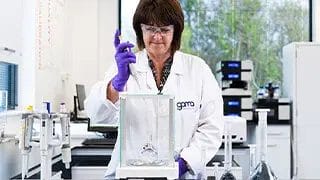Posted
24th March 2022
Research
This week, our Clinical Specialist for Skin Care Category, Georgina Saviolaki, discusses the importance of air filtration in dental rooms and why you should consider using an air purifier during procedures.
In our previous blog post, “Why ventilation is important & the role of air filtration units“, we talked about the role of ventilation in reducing the risk of transmission of infectious pathogens. We then shared a summary of “Factors to consider when choosing an air filter“, where we discussed key criteria when choosing an air filtration system.
In honour of World Oral Health Day earlier this week, we’re discussing the importance of keeping small rooms adequately ventilated, focusing on dental surgeries.
What is ventilation?
Ventilation is a process that moves outdoor or ‘clean’ air into the room, removing any pollutants, providing healthy air. These can include dust, allergens, or pathogenic microorganisms, which can lead to infections. Ventilation is an important measure in Infection Prevention & Control as pathogenic microorganisms are emitted into the room from infected or colonised people, posing a risk to others in the room. Therefore, an effective approach to reduce the concentration of indoor pathogens is to increase ventilation.[1]
The impact of good air filtration
Generally, the more people are in the room the greater the need for effective ventilation. The WHO advise that in case of poor ventilation ‘droplet pathogens’ can spread via droplet route, therefore air filtration is important.[2] Poor ventilation can be overcome with the use of HEPA filters, as they capture pathogenic particles and reduce the risk of transmission. There are two types of HEPA filters: HEPA 13 and HEPA 14. HEPA 14 removes 99.995% of 0.3µm particles whereas HEPA 13 removes 99.95%, rendering HEPA 14 10x more effective. A study showed that using portable air purifiers with HEPA filters, in small healthcare rooms, cleared the aerosols five times faster, compared to rooms without air filtration system.[3]

Ventilation in small rooms and dental practices
Small rooms such as dental surgical rooms in combination with unmasked patients during dental procedures, require the need for adequate ventilation. In addition, the use of Aerosol Generating Procedures (AGP), means dentistry is in a high-risk category for aerosol production and droplet contamination.[4] When such procedures are occurring in small indoor environments, it possesses even a greater challenge to reduce the risk of aerosol transmission.
Procedures and guidance
Government guidance on air purification in dental rooms, emphasises the importance of using artificial ventilator during procedures. It specifies that treatment rooms should have at least 10 Air Changes per Hour (ACH), to achieve particle reduction and minimise the risk of transmission. The guidance states that the clearance of infectious particles after an AGP is also dependent on the ventilation and air changes within the room. Therefore, specialist advice should be sought on how to best achieve the recommended air changes. In addition, NHS guidelines suggest that ventilation rate will also determine the length of post AGP down time (fallow time), as such effective air purification is vital.
GAMA Healthcare’s innovation on medical grade air purifiers
The traditional fitting of Heating Ventilation and Air-Conditioning (HVAC) systems in dental rooms can be costly and will require closure of the practice. However, there’s a lot of innovation on portable devices with HEPA filters, which are a great alternative, as they don’t require fitting time and are cost-effective. However, one of the biggest challenges of introducing portable HEPA filters into existing dental surgery rooms is available space. Many units capable of producing high Clean Air Delivery Rates (CADR), are large and impractical in smaller surgeries.
Rediair
However, Rediair uses twin side intakes and 3 layers of filtration, doubling the CADR without doubling the size of the unit. It’s an instant air purifier with dual HEPA 14 and carbon filters, capturing 99.995% of particles down to 0.3µm. It’s a single unit that provides effective ventilation to rooms up to 120m3, clears 90% of particles within 20 mins removing airborne bacteria, fungi, and viral aerosols. Overall, the HEPA filtration system that is incorporated removes airborne pathogens and increases air circulation.
Find out how many Rediair units you need
Where will you be using Rediair?
How many Air Changes per Hour (ACH) do you need?
Room dimensions
To provide up to 6 air changes per hour in this space you will need:
Rediair unit(s)
Contact us now to order your Rediair units, or find out more about ventilating your space, by filling out the form below.
If you’d like to find out more about our latest innovation in air filtration, visit our Rediair page. Help spread the word about the importance of air ventilation by sharing this article on social media.
[1] United States Environmental Protection Agency. Ventilation and Coronavirus (COVID-19). https://www.epa.gov/coronavirus/ventilation-and-coronavirus-covid-19 Published January 4, 2022. Accessed March 22, 2022
[2] World Health Organization. Coronavirus disease (COVID-19): How is it transmitted? https://www.who.int/news-room/questions-and-answers/item/coronavirus-disease-covid-19-how-is-it-transmitted Updated December 23, 2021. Accessed March 22, 2022
[3] Lee JH, Rounds M, McGain F, et al. Effectiveness of portable air filtration on reducing indoor aerosol transmission: preclinical observational trials. J Hosp Infect. 2022;119:163-169. doi:10.1016/j.jhin.2021.09.012
[4] Proffitt E. What will be the new normal for the dental industry?. Br Dent J. 2020;228(9):678-680. doi:10.1038/s41415-020-1583-x
SHARE THIS ARTICLE
Tags
Latest News
News from the front line: GAMA Healthcare partners with leading Midlands Trust to enhance air quality across two sites
GAMA Healthcare is pleased to announce a significant investment from…
Celebrating 20 Years of GAMA Healthcare: Our Story
This month, GAMA Healthcare celebrates 20 years of helping prevent…
Norovirus: Understanding its transmission and prevention in the UK
Introduction Norovirus is recognised as the leading cause of viral gastroenteritis…
Clean Between to Reduce Healthcare-Associated Infections
Healthcare-associated infections (HAIs) are a significant concern for healthcare facilities…











